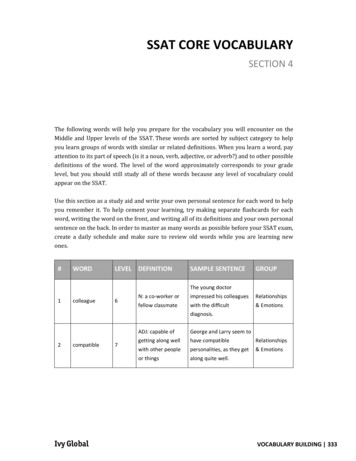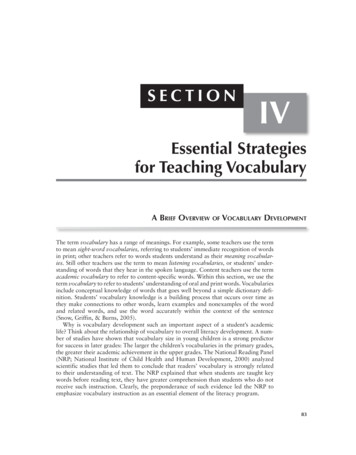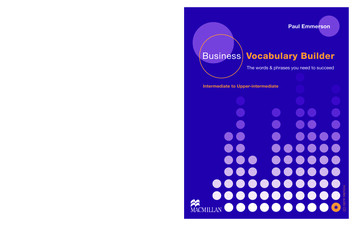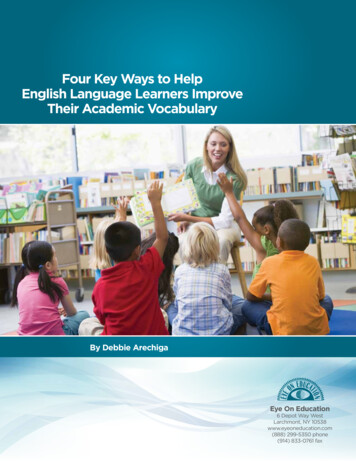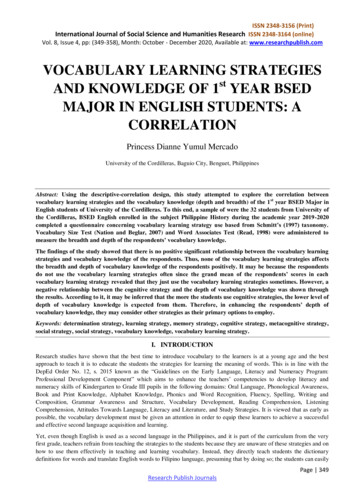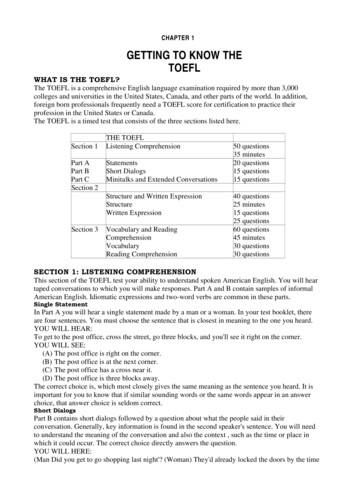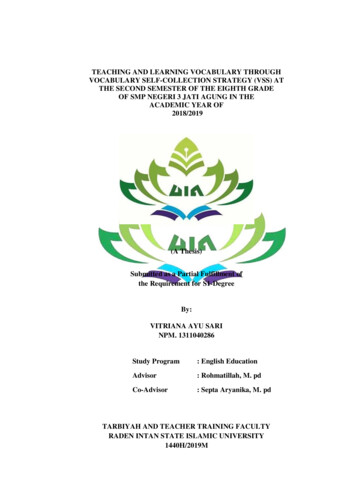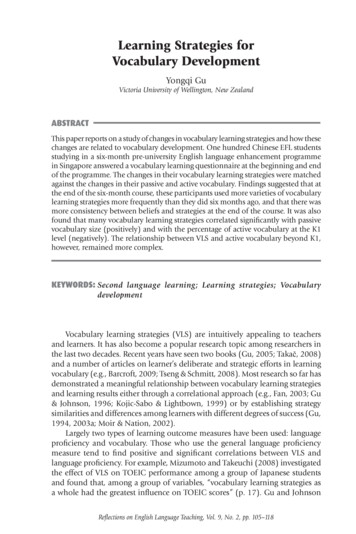
Transcription
Learning Strategies for Vocabulary Development105Learning Strategies forVocabulary DevelopmentYongqi GuVictoria University of Wellington, New ZealandABSTRACTThis paper reports on a study of changes in vocabulary learning strategies and how thesechanges are related to vocabulary development. One hundred Chinese EFL studentsstudying in a six-month pre-university English language enhancement programmein Singapore answered a vocabulary learning questionnaire at the beginning and endof the programme. The changes in their vocabulary learning strategies were matchedagainst the changes in their passive and active vocabulary. Findings suggested that atthe end of the six-month course, these participants used more varieties of vocabularylearning strategies more frequently than they did six months ago, and that there wasmore consistency between beliefs and strategies at the end of the course. It was alsofound that many vocabulary learning strategies correlated significantly with passivevocabulary size (positively) and with the percentage of active vocabulary at the K1level (negatively). The relationship between VLS and active vocabulary beyond K1,however, remained more complex.KEYWORDS: Second language learning; Learning strategies; VocabularydevelopmentVocabulary learning strategies (VLS) are intuitively appealing to teachersand learners. It has also become a popular research topic among researchers inthe last two decades. Recent years have seen two books (Gu, 2005; Takač, 2008)and a number of articles on learner’s deliberate and strategic efforts in learningvocabulary (e.g., Barcroft, 2009; Tseng & Schmitt, 2008). Most research so far hasdemonstrated a meaningful relationship between vocabulary learning strategiesand learning results either through a correlational approach (e.g., Fan, 2003; Gu& Johnson, 1996; Kojic-Sabo & Lightbown, 1999) or by establishing strategysimilarities and differences among learners with different degrees of success (Gu,1994, 2003a; Moir & Nation, 2002).Largely two types of learning outcome measures have been used: languageproficiency and vocabulary. Those who use the general language proficiencymeasure tend to find positive and significant correlations between VLS andlanguage proficiency. For example, Mizumoto and Takeuchi (2008) investigatedthe effect of VLS on TOEIC performance among a group of Japanese studentsand found that, among a group of variables, “vocabulary learning strategies asa whole had the greatest influence on TOEIC scores” (p. 17). Gu and JohnsonReflections on English Language Teaching, Vol. 9, No. 2, pp. 105–118
106Yongqi Gu(1996) used both a general proficiency measure and a vocabulary size measure.However, despite a generally positive correlation between VLS and Englishproficiency and vocabulary size, Gu and Johnson reported that some strategiesaimed at vocabulary retention correlated significantly with vocabulary size butnot with general proficiency. This suggests a dynamic and prolonged nature ofvocabulary development from initial linking and storage of form-meaning pairs(reflected to a certain extent in passive vocabulary size) to a gradual shift of thesewords to the active stock and finally to an integration of words into the generallinguistic competence. A wide array of VLS should, therefore, be used at differentstages of learning to commit words to memory and to automate the use of thesewords in real language use contexts.The overwhelming majority of vocabulary measures in VLS studies havebeen some type of passive vocabulary size measure, in other words, the numberof words a learner can recognize. A number of active vocabulary measures havebeen proposed (Laufer, 1998; Laufer & Nation, 1999; Meara & Bell, 2001; Meara& Fitzpatrick, 2000). However, none of these has been able to satisfactorilymeasure active vocabulary size. One of the most widely used measures of activevocabulary so far is arguably Laufer and Nation’s (1995) Lexical Frequency Profile(LFP), which sketches the profile of a learner’s active vocabulary use by providingthe percentage of words used that belong to the first 1,000 most frequently usedwords, the percentage of the second 1,000 words, that of the Academic Word List,and that of words that do not fall into the lists compared (Morris & Cobb, 2004;Muncie, 2002). Probably due to this lack of a single satisfactory measure of activevocabulary (Meara & Olmos Alcoy, 2010; Read, 2000), practically no VLS studyhas looked at how strategies are related to the growth of active vocabulary.Besides the lack of knowledge on productive vocabulary learning strategies,very little is known about the change of VLS over time; nor do we know muchabout the effect of this change on the development of vocabulary along bothpassive and active dimensions. The only study I am aware of is Cortazzi and Jin’s(1996) cross-sectional description of VLS changes of 212 university students inChina. These students were asked to report on a questionnaire the strategies theywere using, how effective they thought these strategies were, and recall on theiruse of the same strategies when they were in secondary schools. Cortazzi andJin reported that major changes occurred from secondary school to university interms of both VLS and their perceived effectiveness. Strategies used in secondaryschools included mainly reading textbooks, listening to the teacher and takingnotes; whereas a much larger repertoire was reported in university, including moreopportunities for use such as writing essays, listening to radios, and talking toEnglish teachers and native speakers. Some ways of learning vocabulary remainedremarkably stable. These included classroom based activities such as listeningto the teacher and taking notes. Outside the classroom, memorizing vocabularyremained the most widely used strategy.In addition to proficiency growth that demands different strategy use, learningstrategies shift with contexts of learning (Gu, 2003b). In the current study, I aminterested to find whether the dramatic change of learning context from an EFLenvironment in China to an ESL context in Singapore would change the VLS
Learning Strategies for Vocabulary Development107a group of Chinese students used. I examine if the change of VLS is related togrowth in passive and active vocabulary. In particular, the present study aims toanswer the following two research questions:1. Are there significant changes in vocabulary learning strategies after a sixmonth English enrichment programme in Singapore?2. How are vocabulary learning strategies related to vocabulary development(passive vocabulary level and active vocabulary use) at the beginning andend of the programme?MethodSubjectsEvery year, the Singapore government selects a group of students from universitiesin China and supports their study at a university in Singapore. These studentsneed to complete a six-month English language enrichment programme in orderto be able to cope with English-medium instruction in Singapore. The studentswho participated in this study were selected from 14 universities in Chinawhere they had just begun tertiary studies. They filled in a vocabulary learningstrategies questionnaire immediately after a placement test at the beginning ofthe proficiency enrichment programme in Singapore. The same questionnairewas again administered six months later during the last week. One hundredcomplete sets of pre- and post-questionnaires were collected at the end of theprogramme. Seventy three of these were from male students; and 27, fromfemales. The participants’ age ranged from 17 to 21, with the majority of them19 (51%) and 18 (30%). The voluntary nature of the project meant that the datawere not complete for all students. This will be reflected in the varied number ofparticipants for various calculations.Instruments and ProceduresThe instrument used for the elicitation of VLS was Vocabulary LearningQuestionnaire (Version 5, or VLQ5), a ninety-item update by Gu and Hu (2003)of Gu and Johnson’s (1996) VLQ. Each of the ninety statements was followed bya 7-point Likert scale. The Beliefs section ranged from 1, Absolutely disagree, to 7,Absolutely agree. The Strategies section ranged from 1, Absolutely untrue of me, to7, Absolutely true of me. Table 1 lists the major dimensions and categories of VLS,which the VLQ covers (Version 5).The first administration of VLQ5 at the beginning of the programme requiredthe participants to recall how they had been learning vocabulary the previous twoyears before they moved to Singapore. The second administration at the end ofthe programme required the respondents to answer according to how they werelearning vocabulary during the six-month intensive English language training inSingapore. To avoid misunderstanding, the Chinese version of VLQ5 was usedfor both occasions. Table 2 reports the Cronbach’s alpha (α) reliability (internalconsistency) for the two administrations of VLQ5. The reliability of the first
108Yongqi GuTable 1VLQ5: Dimensions, Categories, and Items (Gu & Hu, 2003)Number ofvariablesNumber ofitems212Selective attentionSelf-initiation210Initial handlingGuessingDictionary ble 2VLQ5 Item Distribution and Reliability StatisticsNumber ofitemsα1α2Words should be memorized.Words should be learned through elective extalguessingWider contextImmediate ictionary strategies for comprehensionExtended dictionary strategiesLooking-up kingMeaning-oriented note-takingUsage-oriented esUse of word listsOral repetitionVisual gstrategiesAssociation/elaborationVisual encodingAuditory encodingUse of word structureSemantic encodingContextual 7177.7168.6773.5100.6880Active useActivation strategies5.7557.7442CategoriesStrategiesBeliefs aboutvocabularylearning
Learning Strategies for Vocabulary Development109administration is labelled α1, and that of the second administration is labelledα2.As a quick passive vocabulary measure administered together with thequestionnaires, the 3000-word level of Nation’s (2001)Vocabulary Levels Testwas combined with Goulden, Nation, and Read (1990). Crude as it was, thecombined measure was thought to be indicative of the participants’ learningbackground1 as well as their passive vocabulary level at the time.Active vocabulary was measured by the Lexical Frequency Profile (LFP).This was based on two of the participants’ in-class argumentative compositionscollected from their writing class at the beginning and end of the programme.Their first composition focused on the brain-drain phenomenon in developingcountries, while the last composition was about their arguments for or againstcloning. Each composition was typed and an LFP was obtained by submitting itto Tom Cobb’s Vocabulary Profiler at http://www.lextutor.ca/vp/. For the purposeof this project, the LFP included the number of types, tokens, and word familiescontained in each composition. It also included the percentages of words thatfall into the first 1000 most frequent words (K1), the second 1000 most frequentwords (K2), words that belong to the Academic Word List (AWL) (Coxhead,2000), and off-list words.AnalysisChanges in passive and active vocabulary and changes in VLS over the six-monthperiod were captured by paired t-tests comparing the respondents’ pre- and postvocabulary measures as well as their answers to the pre- and post questionnaires.To examine the effect of strategy use on vocabulary development over the sixmonth programme, Pearson correlations were obtained between VLS on thesecond questionnaire and the passive and active vocabulary measures.FindingsChanges in VocabularySignificant improvement in both passive and active vocabulary was found acrossthe board (Table 3). The passive vocabulary at the end was significantly largerthan that at the beginning of the programme. The one-hour in-class compositionstudents wrote in their last week contained significantly more tokens, more types,and more word families than the composition they wrote in the first week ofthe programme. An average of 89% of the first composition was made up of thefirst 1000 most frequent words. This percentage was reduced to 83% by the endof the six- month programme. In the meantime, the average percentage of K21Most Chinese students place a great emphasis on expanding their vocabulary size, often indiscriminately(Cortazzi & Jin, 1996). For example, many spend years memorising vocabulary lists or even dictionaryentries from A to Z. This results in some very low frequency words being remembered. It was thereforedecided to use Goulden, Nation, and Read (1990) to capture these words that another level in the VLT,e.g., 5,000-word level, would not be able to capture.
110Yongqi GuTable 3Changes in Passive and Active VocabularyMnSDtpPassiveVocabularyVocabulary .000Type/Token words increased from 3% to 5%; the average percentage of AWL words increasedfrom 2% to 5%, and off-list words increased from 6% to 7.45%. These changesindicate in general a significant increase in active vocabulary use. Type/token ratiodropped significantly as well, indicating that the increase in different words usedin compositions did not catch up with the increase of the number of words used.Overall, these figures show a very healthy profile of vocabulary development forthis group of learners over a six-month period.Changes in VLSTable 4 reveals that the participants were active vocabulary learners before theystarted the Singapore programme. For eight out of the 21 variables, the mean scorewas above 4.50; and the mean for Self initiation was 4.82. The participants didnot believe in the memorization of words (M 2.95) and believed that wordsshould be learned through use (M 5.44). Their most often used strategieswere dictionary use (for comprehension 5.40, for usage 5.50, and look-upstrategies 5.12) and contextual guessing (using global context 5.22, usinglocal context 4.85). Their least used strategies included visual repetition (M 3.47) and remembering semantically related words together (Semantic encoding 3.28). At the end of the six-month programme, the strategies often used at thebeginning were still often used. The difference was: all but visual repetition (M 3.54) and memorization (M 3.25) were above the mid-point of 4.00. Thirteen
111Learning Strategies for Vocabulary DevelopmentTable 4Vocabulary Learning Strategies Before and After the 6-month orize words PreMemorize words PostAcquire and use PreAcquire and use 56MetacognitivestrategiesSelective attention PreSelective attention PostSelf-initiation PreSelf-initiation esContextualguessingWider context PreWider context PostImmediate context PreImmediate context PostDictionary Dictionary forstrategiescomprehension PreDictionary forcomprehension PostExtended dictionary use PreExtended dictionary use PostLook-up strategies PreLook-up strategies PostNote-taking Note taking meaning PrestrategiesNote taking meaning PostNote taking use PreNote taking use PostRehearsalUse of word lists PrestrategiesUse of word lists PostOral repetition PreOral repetition PostVisual repetition PreVisual repetition PostEncodingAssociation/elaboration PrestrategiesAssociation/elaboration PostVisual encoding PreVisual encoding PostAuditory encoding PreAuditory encoding PostWord structure PreWord structure PostSemantic encoding PreSemantic encoding PostContextual encoding PreContextual encoding PostActive Use Activation PreActivation -3.71.000-3.98.000
112Yongqi Guout of the 21 variables had a mean score above 4.50. In other words, more varietiesof strategies were used and each strategy was used more frequently than at thebeginning of the programme.Table 4 also suggests that post scores were consistently higher than prescores for all but one variable (extended dictionary use). Except for believingin memorization and association/elaboration, all pre- standard deviations werelarger than post standard deviations. The former means that the participantsused more VLS more often at the end of the programme; the latter indicatesthat the beliefs and strategic learning behaviours of these learners became moreconsistent at the end of six months of intensive English language training. In all,13 out of 21 variables showed statistically significant differences before and afterthe programme. Understandably, the most often used and the least often usedstrategies did not reveal significant differences.VLS and Vocabulary DevelopmentAnswers to Research Question 2 can be found in Table 5. For most strategies,more frequent use of VLS was positively and significantly correlated with passivevocabulary size. The only strategy that was negatively and significantly correlatedwith passive vocabulary was visual repetition (r -.359, p .01). This wasconsistent with previous research (e.g., Gu & Johnson, 1996).The relationship between VLS and active vocabulary, however, was morecomplex than anticipated. VLS were closely related to active vocabulary useof the first 1000 most frequent words. The two belief variables did not revealsignificant correlations with the use of K1 words. But six of the 19 strategy variablesshowed significant and negative correlations with the percentage of K1 wordsin the final composition. In other words, the more often VLS were used, the lesslikely students would stick to K1 words in their active use. Beyond the K1 level,however, the picture was less clear. Believing in memory (r 312, p .004) andusing word lists (r .248, p .025) were found to be significantly correlated tothe percentage of K2 words. The use of off-list words correlated with Selectiveattention (r .331, p .002), using word lists (r .263, p .016), visual encoding(r .363, p .001), auditory encoding (r .284, p .008), semantic encoding(r .240, p .027), contextual encoding (r .247, p .022), and activation(r .252, p .019). These findings suggest that for these students who were stilldeveloping a basic competence in language use, those who deliberately tried tomemorise more words would venture more into the use of words beyond the K1level. Likewise, self-initiation was the only variable that significantly correlatedwith type/token ratio, suggesting that for students at this level, venturing into theuse of unfamiliar words is a motivation as well as a strategy issue. In sum, VLSwere found to be more related to passive vocabulary and more to K1 words thanto less frequent words beyond K1. This phenomenon confirms Laufer’s (2005)contention that lexical knowledge and lexical use develop along different paths,and that small increases in vocabulary size are not necessarily reflected in activeuse.
113Learning Strategies for Vocabulary DevelopmentTable 5VLS and the Passive and Active Use of giesWords should bememorisedWords should belearned thru useSelective attentionSelf initiationContextual Wider contextguessingImmediate contextDictionaryuseDictionary forcomprehensionExtended dictionaryuseLook up strategiesNotetakingNote taking meaningNote taking useRehearsalWord listOral repetitionVisual repetitionEncodingAssociationVisual encodingAuditory encodingWord structureSemantic encodingContextual encodingActive useActivation** p 0.01 rnPost-productive 06082.10083.08783.11383.04683.15083* p 0.05 (2-tailed)AWLOfflist-.036 -.0618285.001 -.0027982.020 .331**8285.075 -.0578386.071.2118386.090.0898285.034 -.0298285.107.0118184.129-.0118183.205.2058386.125 -.0058386-.063 .263*8183.093.2068386-.141 .1298285-.062 .2058386-.150 .363**8285.047 .284**8386-.013 .1418385-.010 .240*8385-.036 .247*8386-.012 .14883
114Yongqi GuDiscussionVLS Changes and Vocabulary GrowthThis study discovered the following main patterns of VLS use before and afterthe 6-month programme: (a) The most often used and the least often usedstrategies remained the same, (b) more varieties of strategies were used andeach strategy was used more frequently at the end of the six-month programme,and (c) the beliefs and strategic learning behaviours of these learners becamemore consistent at the end of the programme. These findings clearly show thatsignificant strategy changes had occurred during these six months. Differences inthe learning environment may well be one of the main factors that led to thesechanges in strategy use. Before the participants’ arrival in Singapore, their mainlearning experiences were in their secondary schools in China, where Englishwas only a subject of study in class; and teachers and textbooks were the mainsources of input. The few months they had in various Chinese universities werelargely similar in terms of the rarity of English language exposure. In contrast,the six-month intensive English enhancement was a total immersion experience,in which English was not only the major focus of study, but also used all thetime for all courses. English was suddenly a live language that could be used toget things done even in the streets. These environmental changes together withthe high stakes nature of the programme demanded different ways of learning,including vocabulary learning.Laufer (1991) singled out two factors that could explain the L2 learner’slexical development, features of the learning situation and features of the learner.Both of these, I argue, are mediated through the learner’s self-initiated effortsand strategic learning. With the change of learning situations, different VLS willneed to be deployed. Contextual influence upon the ways vocabulary is learnedhas been found elsewhere. Laufer and Paribakht (1998), for example, found thatvocabulary knowledge differed between foreign and second language contexts,and that the length of stay beyond two years in the target language communityhad an impact on the gap between passive and active vocabulary.Likewise, as learner proficiency improves dramatically, learning strategiesmore suitable for a higher level of language learning and use will need to beapplied. This phenomenon is explained in Laufer’s (1991) “active vocabularythreshold hypothesis”:Even though our passive vocabulary develops throughout our lifetime, longafter the grammar of a language has been acquired, our productive lexiconwill grow only until it reaches the average level of the group in which we arerequired to function (p. 445).In other words, when learners reach a point where they do not perceive the need toenrich their active vocabulary any more, their efforts and strategies in developinga richer productive vocabulary will stop.
Learning Strategies for Vocabulary Development115VLS and Vocabulary Learning TasksOne of the foci of this study has been the distinction between the learning ofactive and passive vocabulary. Probably due to technical difficulties in studyingactive vocabulary, the lion’s share of attention on L2 vocabulary acquisition hasbeen focused on the development of passive vocabulary. Research so far has shownthat these two aspects of vocabulary follow different routes of development,and that VLS for the development of active vocabulary has largely remainedunknown. Fan (2000) is probably the only study that explicitly tries to discoverstrategies for active vocabulary. However, none of the seven strategy items in herVLS questionnaire that were significantly correlated to her “active vocabularytest” scores (controlled recall) belonged to strategies that aim for the deliberateand active use of vocabulary.It was a little surprising that no significant correlations were found betweenthe percentage of the AWL and VLS. A closer analysis reveals that the importanceof the AWL as a learning focus had not been communicated to the learners. TheSingapore intensive English programme did not single out the AWL as a type ofvocabulary that needed special attention. Learning strategies matter most for thosewords learners pay special attention to. This may explain the lack of meaningfulcorrelations between the AWL and VLS.The significant negative correlations between VLS and K1 words do suggestthe importance of VLS in the development of active vocabulary. However, atleast for this group of learners, this was probably constrained to the first 1000most frequent words only. A combined K1 K2 did not reveal many meaningfulcorrelations with VLS, suggesting that K1 and K2 words are probably developedalong different lines. Beyond K2 has been used as a free active vocabulary measure(Laufer, 1998; Laufer & Paribakht, 1998). In view of the findings from this study,I suggest that K1 and Beyond K1 be used as more sensitive measures of activevocabulary for future research of similar learners.Another insight from this study is that existing VLS measures mostly focuson strategies for passive vocabulary learning tasks, and that VLS for the active useof vocabulary in a second language has not received enough attention. Despitethe explicit “Activation” category of strategies that focused on the active use ofknown or new words, the VLS taxonomy used in this study shares with all majortaxonomies the same lack of attention to strategies that aim for the developmentof active vocabulary. Schmitt’s (1997) taxonomy includes discovery strategies andconsolidation strategies. No items can be found that relate to the developmentof active vocabulary. Stoffer’s (1995) “strategies involving authentic languageuse”, Nation’s (2001) “generating” and Fan’s (2003) “known words” seem to bethe most relevant, but these systems cover even less of an emphasis than Gu andJohnson’s (1996) “activation strategies”. It may well be true that teachers andlearners do not pay as much attention to active vocabulary as they do to passivevocabulary. However, for learners beyond a threshold level of proficiency, VLSaiming at the development of active vocabulary may become a make-or-breaklever. Further research is definitely needed on the nature of such strategies andthe effect they may have on learning results.
116Yongqi GuConclusionVLS are an indispensable tool in describing and explaining the vocabularydevelopment of a foreign language. VLS are also a tool in empowering learnersto make wise decisions in terms of what to learn and how to learn. This studyfocused on the change of VLS when a group of EFL learners moved from Chinato Singapore to begin their tertiary education. As they progressed in a six-monthintensive English proficiency enhancement programme, their passive and activevocabulary improved significantly. Some of these changes could be attributed tothe changes in their VLS which in turn underwent significant shifts. VLS werefound to be related to the growth of passive vocabulary and the participants’ freeuse of active vocabulary at the K1 level. Beyond the first 1000 most frequent words,however, the pattern was not so straightforward. This is thought to have providedevidence to support Laufer’s (1991) “active vocabulary threshold hypothesis”, inthat the development of active vocabulary follows a different pattern from thatof passive vocabulary, and that beyond a threshold level of active vocabulary,growth is dependent on the learner’s perceived need for use.ACKNOWLEDGEMENTI am indebted to Guangwei Hu for his commitment to earlier phases of theproject.THE AUTHORYongqi Gu is a Senior Lecturer at Victoria University of Wellington, New Zealand.He is also an adjunct research fellow at the National Research Centre for ForeignLanguage Education in China. He has extensive teaching and teacher trainingexperiences in mainland China, Hong Kong, Singapore, and New Zealand. Hismain research interests include learner strategies, vocabulary acquisition, andlanguage assessment.Correspondence concerning this article should be directed to Yongqi Gu, Schoolof Linguistics and Applied Language Studies, Victoria University of Wellington,PO Box 600, Wellington 6140, New Zealand; e-mail: peter.gu@vuw.ac.nz.
Learning St
This paper reports on a study of changes in vocabulary learning strategies and how these changes are related to vocabulary development. One hundred Chinese EFL students studying in a six-month pre-university English language enhancement programme in Singapore answered a vocabulary learning qu
